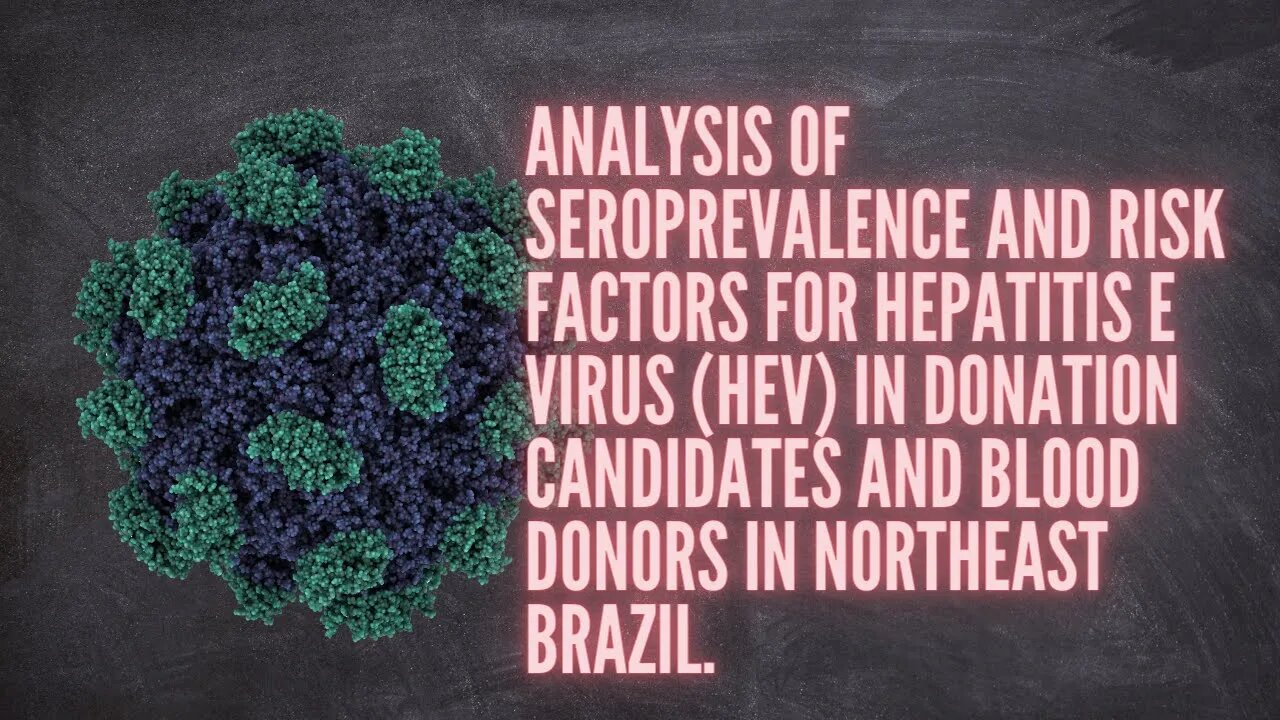Premium Only Content

Hepatitis E virus in donation candidates and blood donors in Northeast Brazil. #HEV #Brazil #Blood
Abstract #HEV #Brazil #Blood
Oral transmission is the main route of hepatitis E virus (HEV) infection; however, genotypes 3 and 4 may also be transmitted by blood transfusion. Individuals who need blood products are often immunosuppressed, which increase the risk of severe disease and death by HEV. Despite this, blood banks in Brazil do not screen for HEV and epidemiological studies in this population are rare; this is an important issue as HEV-3 is frequently identified in the country. Herein, we analyzed the seroprevalence and risk factors for HEV seropositivity in donor candidates/blood donors from Northeast Brazil. Nine hundred and ninety-six donor candidates/blood donors from Foundation of Hematology and Hemotherapy of Pernambuco (HEMOPE) were interviewed regarding socioeconomic, sociodemographic, and behavioral data and analyzed for anti-HEV IgG. Anti-HEV IgG was detected using the HEV IgG (EUROIMMUN) kit. Associations between seropositivity and potential risk factors were analyzed by the χ2 test and Fisher's exact test. Seroprevalence was 0.9% (9/996), 77.77% (7/9) and 22.22% (2/9) in blood donors and donor candidates, respectively. HEV seropositivity was associated with male (OR: 11.65; CI: 0.6755-200.9; p = 0.0163), income higher than BRL 20,000/month (p = 0.0002), and lake bathing (OR: 4.553; CI: 1.391-15.25; p = 0.0258). Importantly, about 43% (3/7) of anti-HEV positive donors made their first donation more than 20 years ago, which must be taken as a warning sign, given the possibility that these individuals may have been infected after registration as donors. Finally, the report of HEV seropositivity, especially in regular blood donors, as well as the identification of potential risk factors, reinforces the need for viral screening in Brazilian blood banks.
-
 LIVE
LIVE
Glenn Greenwald
1 hour agoTrump Tries to End War in Ukraine; U.S. is Dangerously Low on Weapons and Munitions Former Trump DoD Official Warns | SYSTEM UPDATE #502
7,911 watching -
 LIVE
LIVE
Barry Cunningham
1 hour agoPRESIDENT TRUMP HAS ENTERED THE END GAME AND DEMOCRATS ARE NOW IRRELEVANT!
1,585 watching -
 1:01:56
1:01:56
BonginoReport
2 hours agoDems Scramble To Rebrand and it’s a BIG FAIL - Nightly Scroll w/ Hayley Caronia (Ep.114)
22.8K35 -

Katie Miller Pod
5 hours agoEpisode 2 - Sage Steele | The Katie Miller Podcast
1.64K -
 LIVE
LIVE
The Jimmy Dore Show
1 hour agoZelensky Wears SUIT to White House Meeting! MASSIVE Nationwide Protests In Israel! w/ Ryan Cristián
6,314 watching -
 6:32:18
6:32:18
MattMorseTV
7 hours ago $25.32 earned🔴Trump's meeting with Zelenskyy - LIVE🔴
92K69 -
 1:09:56
1:09:56
Kim Iversen
2 hours agoTrump Floats Sending U.S. Troops To Ukraine | Bill And Hillary Clinton Questioned Over Epstein Files
41.7K49 -
 LIVE
LIVE
GritsGG
9 hours agoWin Streaking! Most Wins 3390+ 🧠
160 watching -
 LIVE
LIVE
StoneMountain64
6 hours agoBattlefield 6 Roundup, and NEW MAP for Battlefield 2042 on the Road to BF6
232 watching -
 LIVE
LIVE
Spartan
2 hours agoOctopath 2 into Halo Infinite Ranked (Playing OP2 during infinite ranked queues, pun intended)
52 watching